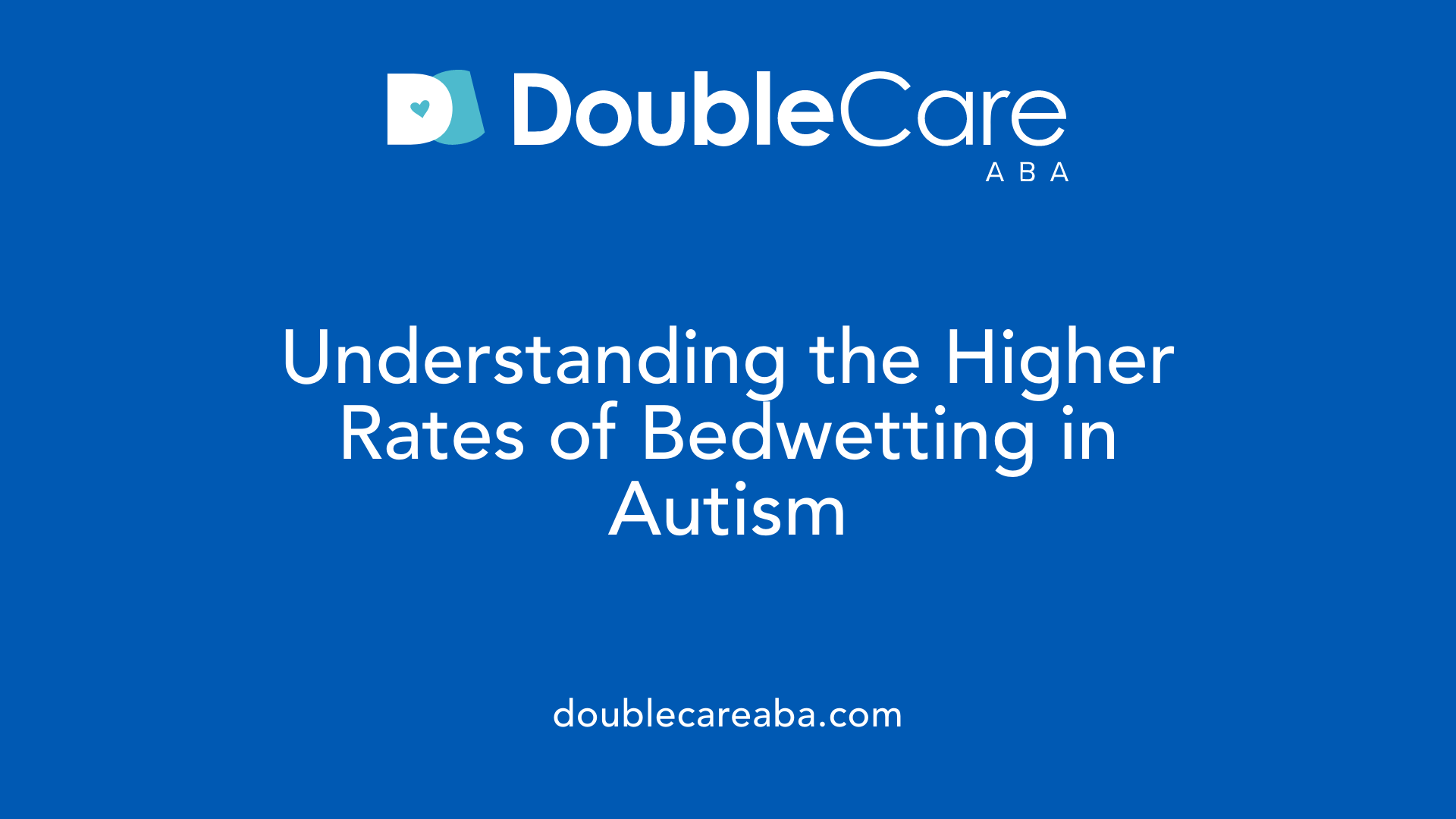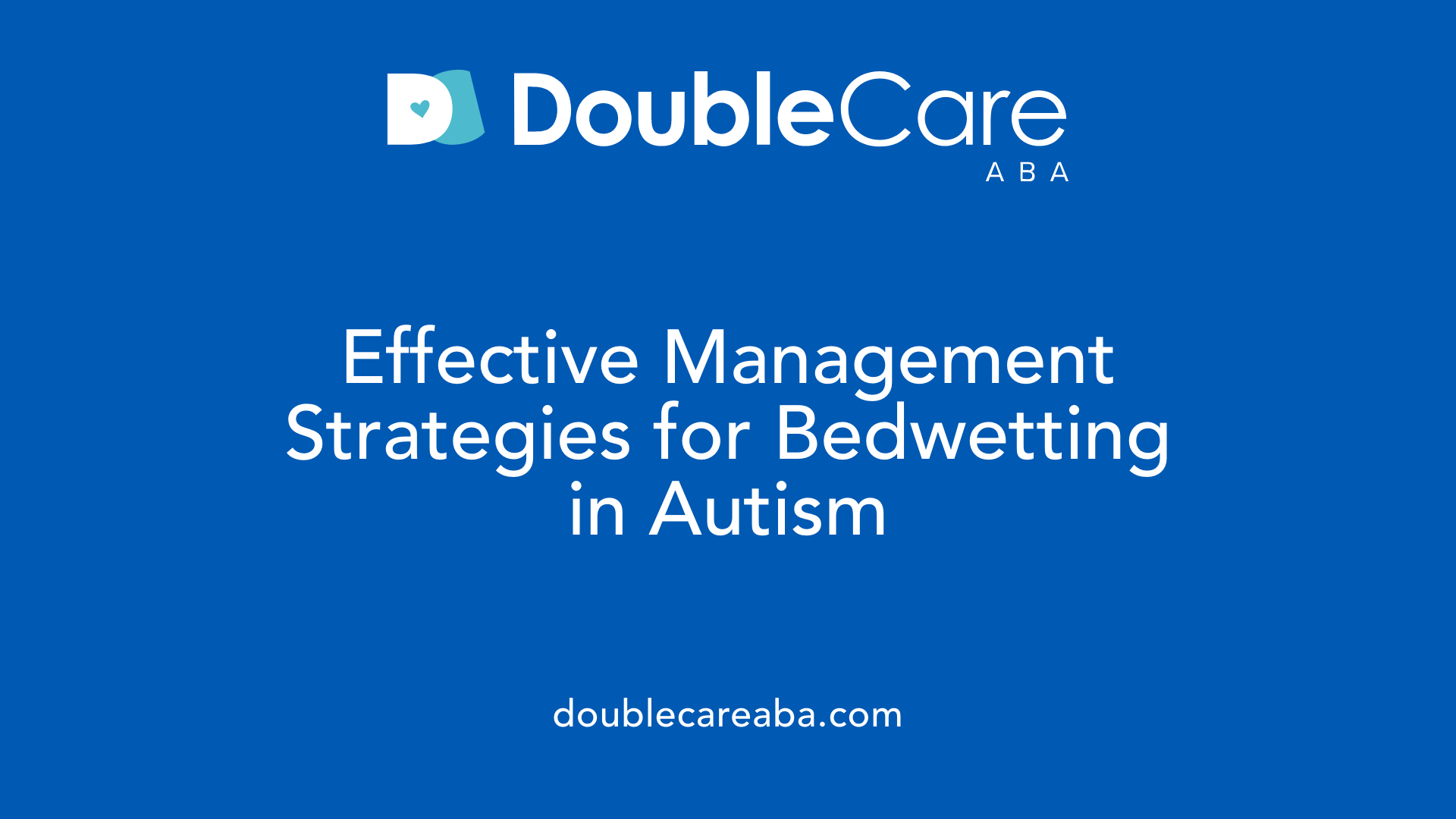Autism and Bed Wetting
Understanding the Link Between Autism and Nocturnal Enuresis

Exploring the Complex Relationship Between Autism and Bedwetting
Autism spectrum disorder (ASD) often presents with a range of developmental, behavioral, and physiological challenges, including a higher prevalence of bedwetting or nocturnal enuresis. This article delves into the underlying causes, effects, and management strategies associated with bedwetting in autistic individuals, aiming to provide a comprehensive understanding of this multifaceted issue.
The Prevalence of Bedwetting in Autism Spectrum Disorder
 Research shows that children and adults with autism spectrum disorder (ASD) are more prone to bedwetting, also known as nocturnal enuresis, compared to neurotypical populations. Studies indicate that among children over the age of five with autism, the prevalence of bedwetting can be as high as 38%. This increased rate persists into adulthood, with over 70% of adults with autism experiencing some form of bladder or bowel dysfunction, including bedwetting.
Research shows that children and adults with autism spectrum disorder (ASD) are more prone to bedwetting, also known as nocturnal enuresis, compared to neurotypical populations. Studies indicate that among children over the age of five with autism, the prevalence of bedwetting can be as high as 38%. This increased rate persists into adulthood, with over 70% of adults with autism experiencing some form of bladder or bowel dysfunction, including bedwetting.
Children with ASD often face challenges that contribute to this condition. They are more likely to experience sleep disturbances such as irregular sleep patterns, sleep apnea, or restless sleep. These sleep issues can make it difficult for them to wake up when they need to urinate. Additionally, sensory sensitivities and developmental delays in bladder control contribute to the higher rates of nocturnal enuresis.
Compared to neurotypical children, those with autism also tend to have delayed bladder and bowel control. For instance, daytime bladder control is often reached later, and bowel control may be delayed significantly, both of which can extend the duration of bedwetting.
The persistence of bedwetting can have substantial emotional and social impacts. Children and their families often experience stress, lowered self-esteem, and family strain. Despite these challenges, behavioral strategies—such as establishing routines, using bedwetting alarms, and practicing good sleep hygiene—along with medical consultations, can help manage the condition.
Understanding the complex relationship between autism and bedwetting involves recognizing factors like sensory processing differences, sleep issues, and medical conditions. Although the exact mechanisms are not fully clear, the connection involves a combination of neurological, behavioral, and sensory factors, emphasizing the importance of supportive, individualized interventions.
Causes and Contributing Factors of Bedwetting in Autism

What are common causes of bedwetting in children and adults with autism?
Bedwetting, also known as nocturnal enuresis, is a complex issue that affects many individuals with autism across different age groups. Several interconnected factors contribute to this condition.
One major cause involves delays in developmental milestones related to bladder control. Children with autism often experience slower progress in developing the ability to recognize bladder fullness or wake up when they need to urinate. This delay can extend into adolescence and adulthood, where bladder regulation remains impaired.
Sleep disorders are another significant factor. Many children with autism experience deep sleep patterns or sleep apnea, which make it difficult for them to wake up during the night to use the bathroom. Restless or disrupted sleep also hinders the ability to respond to bladder signals timely.
Sensory processing issues are common in autism and can impact bladder awareness. Difficulty sensing bladder fullness or responsiveness to internal cues means that some individuals may not recognize they need to urinate until it’s too late, resulting in bedwetting episodes.
Furthermore, the presence of comorbid psychological or medical conditions influences bedwetting. Anxiety, stress, and other mental health challenges, such as attention deficit hyperactivity disorder (ADHD), can exacerbate urinary control problems. Physical health issues like constipation or urinary tract infections (UTIs) also play a role.
Genetic and neurological factors are believed to influence bladder control. Abnormalities in brain regions responsible for bladder regulation, or genetic predispositions affecting urinary function, contribute to higher rates of bedwetting among those with autism.
| Cause Category | Explanation | Additional Notes |
|---|---|---|
| Developmental delays | Slower acquisition of bladder control skills | Especially in recognizing signals and waking at night |
| Sleep disturbances | Deep sleep and sleep disorders inhibit awakening | Such as sleep apnea or irregular sleep patterns |
| Sensory issues | Reduced bladder awareness or hypersensitivity | Affecting the ability to respond to bladder needs |
| Psychological and medical | Anxiety, stress, physical health conditions | Also includes comorbid conditions like ADHD |
| Genetic and neurological | Brain abnormalities or genetic factors | Impacting control mechanisms in the nervous system |
Understanding these factors helps illustrate how multifaceted bedwetting can be in autism, involving behavioral, neurological, and physical components that interact uniquely for each individual.
Autism-Related Sleep Challenges and Their Role in Bedwetting
 Children with autism often face a range of sleep disturbances that can contribute to nocturnal enuresis, or bedwetting. Common symptoms include difficulty falling asleep, frequent night waking, nightmares, and night terrors. These disruptions fragment the sleep cycle and can impair the natural arousal mechanisms that alert children to the need to wake up and use the bathroom.
Children with autism often face a range of sleep disturbances that can contribute to nocturnal enuresis, or bedwetting. Common symptoms include difficulty falling asleep, frequent night waking, nightmares, and night terrors. These disruptions fragment the sleep cycle and can impair the natural arousal mechanisms that alert children to the need to wake up and use the bathroom.
The deeper stages of sleep, especially slow-wave sleep, are more difficult for autistic children to wake from. This deep sleep state can hinder their ability to respond promptly to bladder signals, increasing the risk of bedwetting. Sensory sensitivities, which are prevalent in autism, may also limit a child's awareness or attention to bodily signals of bladder fullness, further complicating nighttime bladder control.
Biological factors play a significant role as well. Many autistic children have lower melatonin levels, the hormone responsible for regulating sleep-wake cycles. Disruptions in circadian rhythms, the internal biological clock that governs sleep patterns, can lead to irregular sleep and wake times, exacerbating sleep disturbances and, consequently, bedwetting.
To address these interconnected issues, various strategies can be employed. Establishing consistent bedtime routines helps create a predictable environment that promotes better sleep. Environmental modifications, such as reducing noise and light, can improve sleep quality. Behavioral interventions, including sleep hygiene education, are useful in managing sleep disruptions.
In some cases, healthcare professionals recommend melatonin supplements to help regulate sleep cycles. These interventions not only improve sleep quality but can also reduce the frequency of bedwetting episodes, making bedtime less stressful for children and their families.
Overall, understanding the link between sleep disturbances and bedwetting in autism enables tailored approaches that improve sleep hygiene and bladder control, ultimately enhancing quality of life for affected children.
Management Strategies for Bedwetting in Autism
 Children with autism often face unique challenges when it comes to bedwetting, also known as nocturnal enuresis. Effective management requires a comprehensive approach that considers the child's sensory sensitivities, behavioral patterns, and possible underlying medical issues.
Children with autism often face unique challenges when it comes to bedwetting, also known as nocturnal enuresis. Effective management requires a comprehensive approach that considers the child's sensory sensitivities, behavioral patterns, and possible underlying medical issues.
One of the main strategies involves behavioral interventions. Techniques such as scheduled awakenings—waking the child during the night to use the bathroom—can be particularly helpful. Bladder training exercises aim to increase bladder capacity and improve control over urination. Visual routines or social stories can support understanding and cooperation around toileting habits, making the process less stressful.
Sensory accommodations also play a critical role. Creating a sleep environment that is comfortable and calming—using weighted blankets, reducing noise, and maintaining a consistent bedtime—can improve sleep quality. Since deep or restless sleep may make it difficult for children to wake up in need of urination, improving sleep hygiene is essential.
Medical evaluation is recommended to rule out physical issues such as sleep apnea, urinary tract infections, or bladder dysfunction. When appropriate, medical devices like bedwetting alarms are used to alert the child when leaks begin, encouraging the development of bladder awareness. In some cases, medications may be prescribed, but these should be used under supervision and as part of a broader management plan.
Addressing co-occurring conditions is also vital. For children with autism, addressing anxiety, constipation, and toileting difficulties can significantly improve outcomes. Managing anxiety through behavioral therapy or relaxation techniques may reduce nighttime stress, which can be a factor in enuresis.
Parental and caregiver support forms the foundation of effective treatment. Educating families about autism-specific challenges and involving healthcare professionals ensures a tailored approach. Collaboration helps in tracking progress, adjusting interventions, and providing emotional support to both children and their families.
In summary, managing bedwetting in children with autism involves combining behavioral strategies, medical assessments, sensory modifications, and emotional support. Tailoring these approaches to each child's needs promotes better sleep, improved bladder control, and reduced emotional distress for the child and family.
Support and Resources for Families Managing Autism-Related Bedwetting
 Managing bedwetting in children with autism and related neurodevelopmental conditions involves a multifaceted approach that combines behavioral strategies, medical interventions, and emotional support.
Managing bedwetting in children with autism and related neurodevelopmental conditions involves a multifaceted approach that combines behavioral strategies, medical interventions, and emotional support.
Support options and interventions for managing bedwetting in neurodivergent populations include behavioral therapies, such as bladder training and establishing consistent bedtime routines, along with medical interventions like bedwetting alarms and appropriate medications, including those used for ADHD. Providing emotional support is crucial to boost self-esteem and reduce anxiety, with an emphasis on normalization and caregiver education to foster understanding and reduce feelings of helplessness.
Addressing sensory sensitivities, environmental challenges, and toileting difficulties—such as communication barriers and sensory overload—is essential. Tailored strategies like visual routines, familiarization with toileting processes, and sensory-friendly environments can make a significant difference. Collaboration with healthcare professionals ensures the management of underlying medical issues like constipation or urinary infections, which can contribute to bedwetting.
Many organizations offer valuable resources for families navigating these challenges. The Autism Society of America partners with support brands such as Goodnites to provide tailored products and educational materials designed specifically for children with autism. These collaborations aim to normalize bedwetting and promote patience and consistency among caregivers.
Fostering understanding and reducing stigma through education is vital. Encouraging a non-punitive approach helps children feel supported and accepted, reducing anxiety and boosting their confidence.
Below is an overview of available support strategies and their focus areas:
| Support Approach | Description | Target Outcome |
|---|---|---|
| Behavioral therapies | Bedtime routines, bladder training, toileting strategies | Improved control, reduced anxiety |
| Medical interventions | Bedwetting alarms, medications for underlying conditions | Increased dryness, medical management |
| Emotional support | Parent training, counseling, peer support groups | Self-esteem, reduced stress |
| Collaboration with healthcare providers | Managing medical issues like infections or constipation | Addressing root causes |
| Organizational partnerships | Education and tailored products via Autism Society of America, Goodnites | Better access to resources, normalization of bedwetting |
Supporting families with patience and consistency, and fostering understanding through education, are essential components in managing bedwetting effectively. By leveraging community resources and maintaining a compassionate approach, families can navigate these challenges more confidently and create a supportive environment for their children.
The Emotional and Social Impact of Bedwetting in Autism
Children with autism often face unique challenges that extend beyond physical symptoms, especially regarding sleep disturbances and bedwetting. These issues can significantly affect their emotional well-being and social participation.
The stress and anxiety experienced by children who wet the bed can be substantial. Many children with autism have difficulties recognizing and communicating their needs, which can lead to frustration and feelings of helplessness. For families, managing bedwetting can be a source of ongoing emotional strain, heightening stress levels and affecting overall family dynamics.
Bedwetting also impacts self-esteem deeply. Children may feel embarrassed or ashamed, which can lead to social withdrawal or avoidance of peer interactions, especially if bedwetting persists into older years. These feelings of shame can be compounded by sensory sensitivities and social misconceptions about autism, making resilience and positive self-image harder to foster.
Family relationships might experience tension, particularly if siblings feel neglected or if parents experience frustration. Open communication and reassurance are crucial in maintaining supportive environments.
Nevertheless, strategies exist to help children build resilience. Creating consistent bedtime routines, employing behavioral interventions such as bedwetting alarms, and providing emotional support can mitigate negative feelings. Encouraging a non-judgmental view of setbacks and celebrating progress can foster confidence.
In summary, addressing the emotional and social ramifications of bedwetting in children with autism is essential. Combining medical, behavioral, and emotional support helps children develop a healthier self-image and supports their social engagement.
A Holistic Approach to Addressing Bedwetting in Autism
Understanding the complex interplay between neurological, behavioral, and sensory factors is essential to supporting autistic individuals facing bedwetting. A combination of medical assessment, behavioral strategies, sensory accommodations, and emotional support can significantly improve outcomes. Collaboration among families, healthcare professionals, and support organizations ensures a patient-centered approach that fosters understanding, patience, and resilience. With continued research and tailored interventions, the goal remains to reduce the physical and emotional burdens of bedwetting and promote healthier sleep and well-being for individuals with autism.
References
- Let's Talk About Autism and Bedwetting
- ADHD, Autism, and Bedwetting: What You Need To Know
- Managing bedwetting in neurodivergent children
- Incontinence in children with autism spectrum disorder
- How to Manage Autism and Incontinence in Adults
- Managing bedwetting in neurodivergent children
- Let's Talk About Autism and Bedwetting
- Recognition and management of bladder bowel ...
- Toileting and autistic children
- Let's Talk About Autism and Bedwetting
















